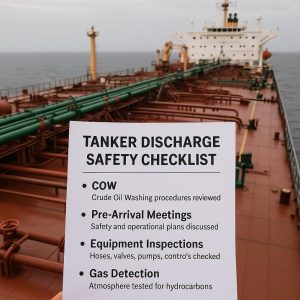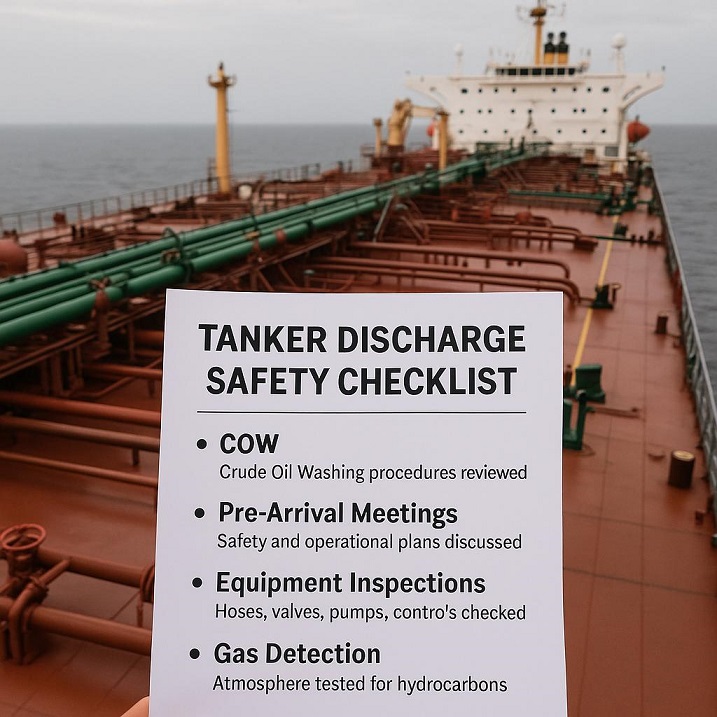A safe and efficient tanker discharge operation relies on strict adherence to key safety protocols, including Crude Oil Washing (COW), pre-arrival meetings, equipment inspections, and gas detection. Before arrival, a pre-arrival shipboard meeting, led by the Chief Officer, ensures all departments are aligned on the discharge plan, mooring arrangements, and safety procedures such as COW, gas purging, and emergency measures. Miscommunication at this stage can lead to delays or even port denials, as seen in a 2023 Singapore incident where an inert gas system misalignment caused a 12-hour delay. Equipment checks—covering manifolds, pumps, lighting, and emergency shutoffs—must be completed 12-24 hours before arrival to prevent accidents and comply with terminal vetting requirements. Additionally, gas detection systems (portable and fixed) must be calibrated and tested for hydrocarbons, H₂S, and oxygen levels, as failures can result in SIRE vetting blacklisting, as occurred in Fujairah in 2024. Together, these measures ensure compliance with ISGOTT, SOLAS, and MARPOL, safeguarding crew, cargo, and the environment while minimizing operational risks.

Part 1: Pre-Arrival Shipboard Meeting for Discharge
Why Pre-Arrival Meetings Are Crucial
Before any cargo operation begins, communication and coordination are key. The pre-arrival shipboard meeting sets the foundation for a smooth and safe discharge. This meeting, generally chaired by the Chief Officer and attended by senior deck and engine officers, is not merely procedural—it is a legal and safety necessity. ISGOTT, SOLAS, and terminal requirements all emphasize this stage as part of risk mitigation.
These meetings ensure that everyone is briefed on the schedule, procedures like COW or gas purging, and emergency measures. Miscommunication at this stage can result in delays, unsafe operations, or even fines from port authorities.
Key Topics Discussed During the Meeting
- Cargo Discharge Plan: Approved by the Master and coordinated with the terminal.
- Mooring Arrangements: Verified against port requirements and weather forecasts.
- Special Operations: COW, gas purging, tank cleaning, or ballasting sequences are confirmed.
- Safety Procedures: Includes cargo watch schedules, hot work restrictions, and enclosed space entry policies.
- Crew Awareness: All watchstanders are reminded of port security, PPE standards, and restricted areas.
- Engine Department Briefing: Ensures auxiliary equipment readiness, such as IGS blowers and power availability.
- Galley & Housekeeping Instructions: Garbage segregation, visitor control, and galley hours are aligned with port rules.
Documentation and Compliance
Meeting notes are recorded in the Cargo Record Book and/or ship’s safety meeting log. Checklists are cross-checked with ISGOTT standards. Failure to document the meeting may trigger deficiencies during Port State Control (PSC) inspections.
Real-World Example: Delayed Discharge in Singapore
In 2023, a tanker at Jurong Island Terminal faced a 12-hour delay because the pre-arrival safety meeting failed to inform the engine room that the inert gas generator was to be activated early. Misalignment between departments caused terminal denial of berthing, proving how critical this coordination is.
Part 2: Pre-Arrival Equipment Checks on Tankers
Ensuring Equipment Readiness Before Port Entry
Before reaching port, it is essential to complete all cargo handling equipment checks. These inspections not only align with terminal vetting requirements but also serve as a first line of defense against accidents and operational delays. The Chief Officer usually leads this process 12 to 24 hours before arrival.
Critical Equipment to Check
- Manifold Reducers and Flange Integrity: Ensure correct fittings, proper gaskets, and clean manifolds.
- Compound Pressure Gauges: Inspect for accurate readings and replace any faulty units.
- Deck & Pump Room Lighting: Confirm all areas are well lit, especially emergency lighting.
- Pump Room Safety: Clean, gas-free, and with no loose materials. Confirm exhaust fans are operational.
- Communication Systems: Radios, transceivers, and internal talk-back systems must be tested.
- Hydraulic Remotes & Emergency Shutoffs: Tested for functionality and labeled clearly.
Documentation and Handover
Checklists are often maintained in the Safety Management System (SMS) and reviewed during Master-Chief Officer briefings. Findings, faults, and resolutions are documented to prevent repetition or missed repairs.
Analogy: Preparing for Surgery
Think of this process like prepping an operating theatre before surgery. Every tool, light, and monitor must function perfectly. The safety of the patient (here, the vessel and port) depends on readiness.
Part 3: Gas Detection Equipment Checks Before Port Entry
Importance of Gas Detection in Tanker Operations
Gas detection equipment plays a critical role in preventing fire, explosion, and toxic exposure incidents. According to ISGOTT and OCIMF, pre-arrival checks ensure that hydrocarbon (HC), hydrogen sulfide (H₂S), and oxygen (O₂) levels can be accurately monitored during tank entry or operations like COW and purging.
What Needs Checking
- Portable Detectors: Calibrate HC, H₂S, and O₂ meters using span gas. Check batteries and filters.
- Sensor Placement: Confirm placement at the pump room entrance, tank top, and ballast tanks.
- Fixed Detection Systems: Test alarms, sensor functionality, and panel display diagnostics.
- Sample Lines: Ensure no water ingress. Flush lines and check flow meters.
- Pump Room Sampling: Shut down gas sample pumps if tanks are known to be safe, as per terminal expectations.
- Valve Closures: Valves leading to water lines should be tightly shut to avoid contamination.
Aligning with Vetting and PSC Requirements
Port State Control inspections and SIRE vetting protocols (OCIMF) increasingly scrutinize gas detection logs and calibration records. Non-compliance here is a red flag for ship safety culture.
Example: SIRE Vetting in Fujairah
In 2024, a tanker failed a SIRE inspection because the portable gas detectors showed outdated calibration stickers. The ship was blacklisted for 90 days. This emphasizes that even minor oversights in gas detection can have significant operational consequences.
Frequently Asked Questions (FAQ)
1. What is the primary purpose of Crude Oil Washing (COW)?
To remove clingage from tank surfaces, reduce sludge buildup, improve cargo discharge efficiency, and comply with MARPOL regulations.
2. Who conducts the pre-arrival shipboard safety meeting?
The Chief Officer usually leads the meeting with senior officers from deck, engine, and galley departments.
3. Are gas detectors mandatory on all tankers?
Yes. Both portable and fixed detectors are required under SOLAS and ISGOTT for monitoring HC, H₂S, and O₂.
4. Can equipment checks be deferred until after berthing?
No. Pre-arrival checks are a mandatory requirement under ISGOTT and terminal vetting protocols. Delays or penalties may occur otherwise.
5. What happens if one of the pre-arrival checks fails?
It must be rectified before proceeding. Terminal authorities and Class may require re-inspection or approval to continue operations.
Conclusion
Efficient and safe tanker discharge operations depend on four interconnected practices: COW execution, pre-arrival safety meetings, thorough equipment checks, and calibrated gas detection. Each supports the others in safeguarding crew, cargo, terminal, and marine environment.
By embedding these protocols into daily routines and drills, officers and crew not only comply with international standards but also strengthen operational readiness. This comprehensive understanding is essential for all stakeholders—cadets, junior officers, superintendents, and marine safety trainers.
References
- International Maritime Organization. (n.d.). MARPOL Annex I. https://www.imo.org
- SOLAS Convention. (n.d.). Regulation II-2/61. https://www.imo.org
- ISGOTT 6th Edition. (2020). International Safety Guide for Oil Tankers and Terminals.
- OCIMF. (2020). Crude Oil Washing Operations and Best Practices.
- Tanker Discharge Operations Manual – Chapter 1
- Paris MoU Reports. https://www.parismou.org
- The Nautical Institute. https://www.nautinst.org
- SIRE Vetting Inspection Guidelines. https://www.ocimf.org
- BIMCO Guidelines on Tanker Safety. https://www.bimco.org
- Maritime and Coastguard Agency (UK). https://www.gov.uk/government/organisations/maritime-and-coastguard-agency

